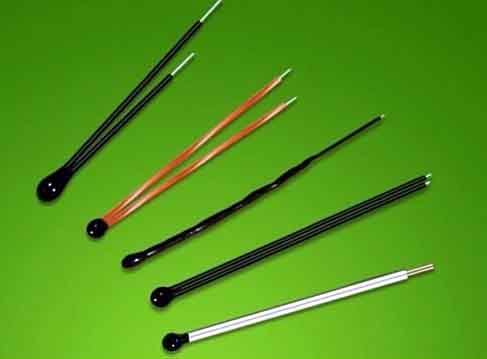Semiconductor Negative Temperature Coefficient Characteristics of NTC Thermistors

NTC (Negative Temperature Coeff1Cient) is a thermistor phenomenon and material with a negative temperature coefficient that decreases exponentially with increasing temperature. The material is a semiconductor ceramic obtained by sufficiently mixing, molding, sintering, or the like using two or more kinds of metal oxides such as manganese, copper, silicon, cobalt, iron, nickel, and zinc. Can be made into a thermistor with a negative temperature coefficient (NTC). Its resistivity and material constant vary with material composition ratio, sintering atmosphere, sintering temperature and structural state. Now there are non-oxide NTC thermistor materials represented by silicon carbide, tin selenide, tantalum nitride, etc.
NTC heat-sensitive semi-conductive porcelain is mostly a spinel structure or other structure of oxide ceramics, with a negative temperature coefficient, the resistance value can be approximated as:
Where RT and RT0 are the resistance values at temperatures T and T0, respectively, and Bn is the material constant. The ceramic grain itself changes the resistivity due to temperature changes, which is determined by the semiconductor characteristics.
The development of NTC thermistors has gone through a long period of time. In 1834, scientists first discovered the property of silver sulfide with a negative temperature coefficient. In 1930, scientists discovered that cuprous oxide-copper oxide also has a negative temperature coefficient performance, and successfully used in the temperature compensation circuit of aviation instruments. Subsequently, due to the continuous development of transistor technology, the research of thermistor has made significant progress. In 1960, the N1C thermistor was developed. NTC thermistors are widely used in temperature measurement, temperature control, temperature compensation and other aspects. The following is an application example of temperature measurement. The principle of NTC thermistor temperature measurement is shown in Figure 4.
Its measurement range is generally -10 ~ +300 ° C, can also be -200 ~ +10 ° C, and can even be used in the environment of +300 ~ +1200 ° C for temperature measurement.
RT is an NTC thermistor;
R2 and R3 are bridge balancing resistors;
R1 is the starting resistance;
R4 is a full scale resistor, and the check head is also called a check resistor;
R7, R8 and W are voltage divider resistors to provide a stable DC power supply for the bridge.
R6 is connected in series with the meter head (microampere meter) to correct the head scale and limit the current flowing through the meter head.
R5 is connected in parallel with the meter head for protection.
Connect a thermal element RT to the temperature sensor probe on the unbalanced bridge arm (ie R1, RT).
Since the resistance value of the thermistor changes with temperature, the indication of the head connected between the diagonals of the bridge also changes accordingly. This is how the thermistor thermometer works.
The accuracy of the thermistor thermometer can reach 0.1 °C, and the temperature sensing time can be as low as 10 s. It is not only suitable for granary thermometers, but also for temperature measurement in food storage, medical and health, scientific farming, oceans, deep wells, high altitudes, glaciers, etc.
II. CTR thermistor
The critical temperature thermistor CTR (CritiCal Temperature Resistor) has a negative resistance mutation characteristic. At a certain temperature, the resistance value decreases sharply with the increase of temperature, and has a large negative temperature coefficient. The constituent material is a mixed sintered body of elemental oxides such as vanadium, niobium, tantalum, phosphorus, etc., which is a semi-glassy semiconductor, also called CTR is a glass-state thermistor. The sudden change temperature changes with the addition of oxides such as antimony, tungsten and molybdenum. This is due to the incorporation of different impurities, resulting in different lattice spacing of vanadium oxide. If vanadium pentoxide is changed to vanadium dioxide in a suitable reducing atmosphere, the temperature of the electrical resistance is increased; If it is further reduced to vanadium pentoxide, it will suddenly disappear. The temperature at which the resistance is rapidly changed corresponds to the position where the semi-glass semiconductor material is sharply changed, thus producing a semiconductor-metal phase shift. CTR can be used as a temperature control alarm and other applications.
The theoretical research and application development of thermistors have achieved remarkable results. With the application of high, precise and sharp technology, the deeper exploration of the conductive mechanism and application of the thermistor, as well as the in-depth study of new materials with excellent performance, will achieve rapid development.





